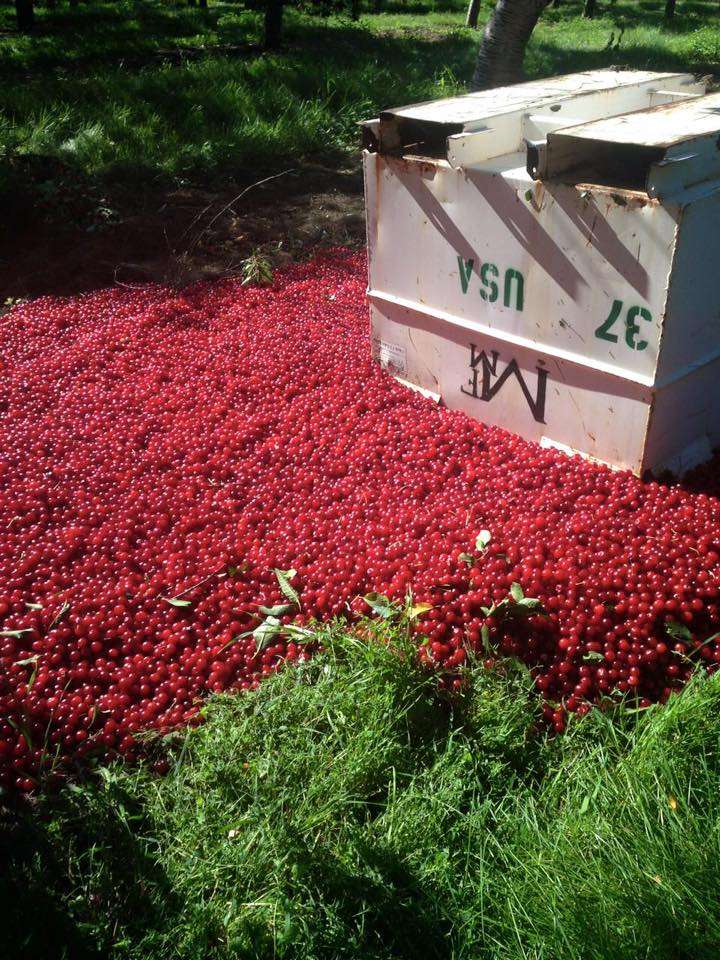Dumped Cherries a Reminder of Awfulness of USDA Marketing Orders
Hurting farmers and consumers. Squeezing out competitors. Forcing production abroad. Causing food waste. What's not to love?


Two years ago, I wrote about an ongoing lawsuit that's pitted a Michigan cherry farmer against a "stupid" USDA-supervised industry group known as the Cherry Industry Administrative Board (CIAB). Somehow, that 2011 lawsuit is still making its way through the courts.
But the cherry board is back in the news this month, after Michigan cherry farmer Marc Santucci posted a photo of a sea of cherries he's been forced to dump to comply with the tart cherry marketing order, a program of the USDA's CIAB.
The viral image outraged those who saw it.
Santucci, a Traverse City, Mich. farmer, says he posted the photo on Facebook "because I want people to know that we sometimes do stupid things in this country in [an] attempt to do the right thing—we end up doing the wrong thing."
The cherry board is, categorically, the wrong thing.
The CIAB declares it "was created to assist the industry in dealing with the erratic production cycle of red tart cherries and to improve returns to the growers and processors of red tart cherries in the United States." Its "primary goal is to establish orderly marketing conditions by alleviating supply/demand imbalances," reads a 1985 report issued by the GAO.
In service of this goal, the board oversees all cherry handling in at least seven states. It sets annual quotas for tart cherries, establishing the portion of each year's cherries that may reach the marketplace.
A marketing order—and cherries represent just one of many enforced by the USDA—is just that: an order. "A marketing order, with or without handler approval, is binding on all handlers in the industry," reads a 1975 USDA report on marketing orders. Compliance is not optional.
"One key purpose of these marketing orders is to restrict the supply of a designated agricultural product in order to make that product more expensive," I describe in my forthcoming book, Biting the Hands that Feed Us (pre-order it now!). "Supporters claim this rewards producers and marketers by guaranteeing income, promoting the agricultural products to potential consumers, and fostering order in the marketplace."
Maybe that sounds nice. But marketing orders have been a source of controversy since Congress first created them in the late 1930s. Take the 1985 GAO report, which refers to marketing orders as a "controversial program," and which concluded that marketing orders "have the potential to restrict new farmers from entering the marketplace" and to create food waste.
"Critics often oppose [marketing orders] on the grounds that economic efficiency is enhanced when commodity prices and the total supply of products reaching the marketplace are determined in competitive markets," the GAO report also details. "They assert that consumer interests are undermined by policies that artificially and excessively raise food prices higher than free market conditions would allow."
These are just some of the issues created by marketing orders.
Santucci notes one perverse effect of the cherry rules is that by artificially depressing the domestic cherry supply, the rules simply increase demand for (and, consequently, the supply of) foreign-grown cherries on the U.S. market.
In addition to wasting harvested cherries, the marketing order has been responsible in recent years for causing farmers to abandon their crops to rot instead of harvesting them. Notably, that was also an issue in the early 1980s, according to the GAO report, which cited another federal report that referred to the tart cherry marketing order as a "regulation that induces growers to abandon part of their crop in the field."
Such government-mandated waste is an outrage. Worse still, the excess cherries, Santucci notes, can't be given away or donated.
If the cherry marketing order sounds counterproductive at best, its supporters would disagree.
"It was created at the industry's behest," said Perry Hedin, head of the cherry board. "It was voted in by growers and processors. It's not an imposition from outside."
This inside imposition, coupled with the ongoing 2011 lawsuit against the cherry board, calls to mind a recent Supreme Court case, filed by raisin handler Marvin Horne, that centered on the USDA's marketing order for raisins. I saw the case's two Supreme Court arguments live, wrote about the case extensively, wrote and filed an amicus brief in support of Horne, appeared on MSNBC to discuss the case, and devote several pages of my book to the case's dénouement.
The rules in Horne are similar to those pertaining to cherries. But the Horne case involved a physical taking (of money or raisins) by the USDA. Unfortunately, the Supreme Court's ruling in Horne suggests that marketing orders that set quotas, like those set by the cherry board, are likely to survive any challenge.
That means the Horne case is unlikely to be the final nail in the coffin for USDA marketing orders. Sooner or later, though, these rules must—and will—fall.


Show Comments (245)